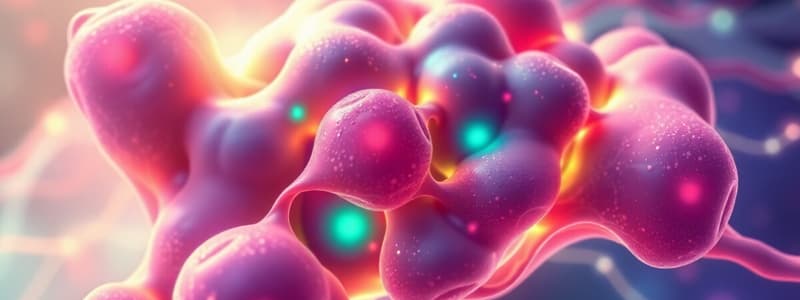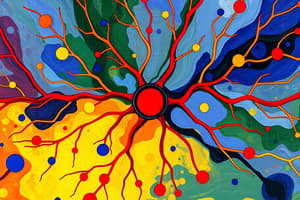Podcast
Questions and Answers
What is the primary function of sensory receptors in an organism?
What is the primary function of sensory receptors in an organism?
- To detect changes in the environment (correct)
- To transmit nerve impulses
- To coordinate responses from the brain
- To generate muscle contractions
What is the resting potential of a neuron?
What is the resting potential of a neuron?
- A negative charge across the neurone membrane (correct)
- Equal distribution of electrical charges
- No change in electrical charge
- A positive charge across the neurone membrane
What initiates the action potential in a neuron?
What initiates the action potential in a neuron?
- Increased permeability to sodium ions (correct)
- Stimulation of effector muscles
- Decreased potassium ion movement
- Movement of chloride ions
Which ions predominantly move across the neurone membrane during the action potential?
Which ions predominantly move across the neurone membrane during the action potential?
What type of ion channels are responsible for the rapid influx of sodium ions during the action potential?
What type of ion channels are responsible for the rapid influx of sodium ions during the action potential?
What primarily determines the resting membrane potential in a neurone?
What primarily determines the resting membrane potential in a neurone?
What is the role of the central nervous system in the neuron signaling process?
What is the role of the central nervous system in the neuron signaling process?
Which configuration describes the state of the neurone membrane prior to action potential generation?
Which configuration describes the state of the neurone membrane prior to action potential generation?
During the action potential, which ion's conductance increases first?
During the action potential, which ion's conductance increases first?
What does the sodium-potassium pump primarily function to do?
What does the sodium-potassium pump primarily function to do?
What occurs during the repolarization phase of an action potential?
What occurs during the repolarization phase of an action potential?
Which ion channel type is responsible for maintaining resting potential?
Which ion channel type is responsible for maintaining resting potential?
What is the main impact of the hyperpolarizing afterpotential?
What is the main impact of the hyperpolarizing afterpotential?
How is conduction velocity along a nerve fibre increased?
How is conduction velocity along a nerve fibre increased?
What is the significance of having more sensory receptors in an area?
What is the significance of having more sensory receptors in an area?
What does the time constant (τ) refer to in the context of nerve physiology?
What does the time constant (τ) refer to in the context of nerve physiology?
What initiates the local circuit of depolarization along the nerve fibre?
What initiates the local circuit of depolarization along the nerve fibre?
Which ion primarily floods into the neurone during depolarization?
Which ion primarily floods into the neurone during depolarization?
What is the role of myelin in nerve fibers?
What is the role of myelin in nerve fibers?
What triggers the release of acetylcholine at the neuromuscular junction?
What triggers the release of acetylcholine at the neuromuscular junction?
What happens to Na+ channels upon the binding of acetylcholine at the motor end plate?
What happens to Na+ channels upon the binding of acetylcholine at the motor end plate?
Which structure contains acetylcholine in the neuromuscular junction?
Which structure contains acetylcholine in the neuromuscular junction?
What is the functional significance of the Node of Ranvier in myelinated fibers?
What is the functional significance of the Node of Ranvier in myelinated fibers?
What is the valence of calcium ions (Ca2+)?
What is the valence of calcium ions (Ca2+)?
How is the resting membrane potential calculated?
How is the resting membrane potential calculated?
What is the significance of the concentration gradient in resting membrane potentials?
What is the significance of the concentration gradient in resting membrane potentials?
What formula gives the equilibrium potential for sodium (Na+)?
What formula gives the equilibrium potential for sodium (Na+)?
At what temperature is the equation $E (mV) = 61.log10 \frac{Co}{Ci}$ simplified for use?
At what temperature is the equation $E (mV) = 61.log10 \frac{Co}{Ci}$ simplified for use?
For sodium ions, if the concentration outside the cell is 150 and inside is 15, what is the value of E (mV)?
For sodium ions, if the concentration outside the cell is 150 and inside is 15, what is the value of E (mV)?
What primarily determines the resting membrane potential?
What primarily determines the resting membrane potential?
Which of the following ions has a valence of -1?
Which of the following ions has a valence of -1?
What is the general role of nerve and muscle cells regarding resting membrane potential?
What is the general role of nerve and muscle cells regarding resting membrane potential?
At 20°C, how is the equation for equilibrium potential adjusted?
At 20°C, how is the equation for equilibrium potential adjusted?
What type of gated ion channel responds to voltage changes?
What type of gated ion channel responds to voltage changes?
What is the primary role of ligand-gated channels?
What is the primary role of ligand-gated channels?
During which phase of the action potential does depolarization occur?
During which phase of the action potential does depolarization occur?
What effect does an action potential primarily have on membrane potential?
What effect does an action potential primarily have on membrane potential?
What is the term for the period when a region behind an action potential cannot generate a new one?
What is the term for the period when a region behind an action potential cannot generate a new one?
How is the membrane potential conventionally measured?
How is the membrane potential conventionally measured?
What defines the equilibrium potential?
What defines the equilibrium potential?
What is the Nernst equation used for?
What is the Nernst equation used for?
Which of the following channels are always open?
Which of the following channels are always open?
Which stage immediately follows depolarization in an action potential?
Which stage immediately follows depolarization in an action potential?
Flashcards are hidden until you start studying
Study Notes
Neuronal Membrane Potential
- Resting neurone membrane exhibits a negative charge inside (-70mV to -80mV) and a positive charge outside due to ion distribution.
- High permeability to K+ and Cl- establishes a resting membrane potential close to equilibrium potential.
- Low permeability to Na+ and Ca2+ keeps resting membrane far from their equilibrium potential.
Action Potential Phases
- Resting Membrane Potential: Around -70mV with high K+ conductance and low Na+ conductance.
- Depolarization: Inward current causes membrane to depolarize, leading to increased Na+ channel permeability.
- Repolarization: Na+ channels close slowly, K+ channels open rapidly, significantly increasing K+ conductance.
- Hyperpolarizing Afterpotential: K+ conductance remains higher than resting levels, resulting in undershoot.
Conduction Mechanism
- Temporary depolarization causes a local circuit effect, facilitating electrical impulse spread to adjacent resting areas.
- Voltage-gated Na+ channels are activated, allowing sodium influx and generating an action potential.
- Action potentials propagate with specific conduction velocities.
Factors Influencing Conduction Velocity
- Increased nerve diameter enhances conduction speed.
- Ion valences affect electrical properties; Na+ & K+ (+1), Cl- (-1), Ca2+ (+2).
- Temperature influences neuronal activity.
Equilibrium Potentials Calculation
- Using the formula: E (mV) = 58.log10(Co/Ci) with adjustments for valence (z) and temperature.
- Calculated equilibrium potential for Na+ is +58mV, based on extracellular (150mM) and intracellular (15mM) concentrations.
Membrane Potential Characteristics
- Resting potential arises from polarization; the inside of the cell is compared to the outside, which is considered zero.
- Changes in electrical charges are managed through sodium and potassium ion movements.
Types of Ion Channels
- Gated Channels: Open in response to stimuli (voltage, ligands, mechanical pressure).
- Leakage Channels: Always open, allowing continuous ion movement.
- Ion diffusion can significantly exceed predictive rates due to selective permeability.
Neuromuscular Junction Components
- Motor units consist of a motor neuron and the muscle fibers they innervate.
- The junction is chemically linked by acetylcholine, released from vesicles at the axon terminal.
- The synaptic cleft (20-30 nm) separates the axon terminal from muscle cell membranes.
Events at the Neuromuscular Junction
- An action potential at the axon terminal opens Ca2+ channels, triggering acetylcholine release.
- Acetylcholine binds to receptors on the motor end plate, opening Na+ channels and generating depolarization (end plate potential).
- Na+ entry leads to action potential initiation in muscle fibers, facilitating contraction.
Studying That Suits You
Use AI to generate personalized quizzes and flashcards to suit your learning preferences.




